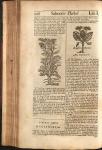Chap. 146. Of Colewort, Sea.
 This chapter hasn't been proofread yet.
This chapter hasn't been proofread yet.
I. The Names. It is called in Greek, Κ&μβ_ ikujrf : In Latin, Brassica Marina, Brassica Mar na multiflora, Brassica Maritima Bauhini, Brasica Marina Monospermos, Brassica Marina Anghca Gerardi: In English, Sea Colewort.
II. The Kinds. It is the last of the principal forts of Coleworts, and a singular Plant of the Kind.
III. The Description. It has a Root somewhat Great, shooting forth many Branches under ground, having many Fibres also adjoined, and keeping its Leaves green all the Winter. From this Root rise up several somewhat broad and large, thick wrinkled Leaves, and as it were curled about the edges, growing each upon a several thick Footstalk, very easie to be broken, and so tender, that they can scarcely be handled without breaking, of a greyish green color ; from among which rises up a strong thick Stalk, two feet or more high >, Cubits, says Gerard, with some Leaves thereon, up to the top, where it branches much out; on every Branch stands a large Buff of pale whitish Flowers, consisting of four Leaves a-piece, which being past away, small roundish, or thick and short Pods come forth, containing each but one roundish, greyish Seed apiece, of the bigness of a Tare, or Vetch, and much greater than Soldanella, or Sea Bindweed, to which Plant this Sea Colewort is not in the least measure akin though some Authors have mistaken the former, viz. Soldanella for this latter.
IV. The Places. It grows in many places upon the Coast of England, as well on the Kentish as Essex shore ; at Lidde in Kent, and at Colchester in Essex : Gerard says it grows Naturally upon the Bayche and Shores of the Sea, whete there is no Earth to be seen but Sand, and Rouling Pebble Stones, which they who grow near the Sea, call, Bayche : he found it growing between Whitstable, and the Jfte of Thanet, near the Brink of the Sea, and in many places near to Cochester, and in other places by the Sea side.
V. The Times. It Flowers in the end of June, and all July, and the Seed is ripe towards the end of august.
VI. The Qualities, Specification, Preparations and Virtues, are the same with those of the Garden Colewort, ( except those various Preparations and Uses of them for Food ) but in all the cafes there mentioned, this is the stronger, and more efficacious.
VII. Note 1. The Decoction of the Sea Colewort, (some Authors say) doth by its bitter Quality, and sharp Nitrous Particles, open the Belly, and purge the Body but as Galen thinks, not without some hurt or damage thereto, because it differs much from the Temperature of our Bodies, being hotter and drier than the Garden Kinds: For as all other
Wild Herbs are more potent or stronger in their Operations, is also this for which reason it digests and cleanses more powerfully than the others do.
VIII. Note 2. The young Leaves' boiled in Lye of Pot-Ashes, ( as Dioscorides says,) or in Fair Water (as is most usual in our times) are eaten as other Coleworts are, by several poor People near the Sea, the boiling taking away much of the bitterness thereof.
IX. Note 3. The young Leaves, or their Juice, applied to Sores or Ulcers, cleanses and heals them, dissolves Tumors, or Swellings, and takes away Inflammations.
Botanologia, or The English Herbal, was written by William Salmon, M.D., in 1710.

 Page 242
Page 242 Page 243
Page 243